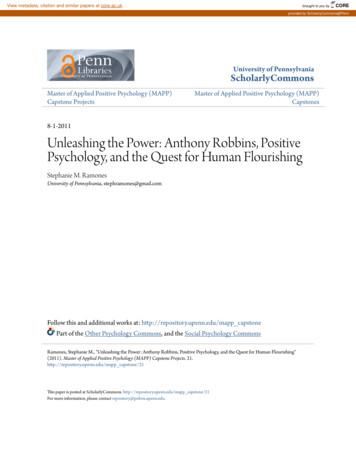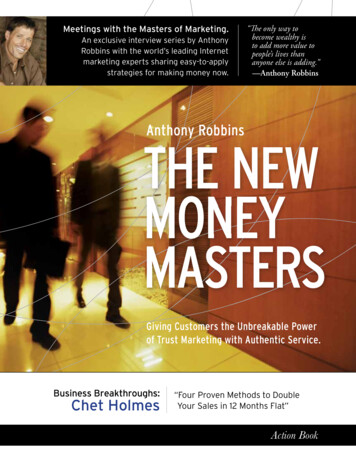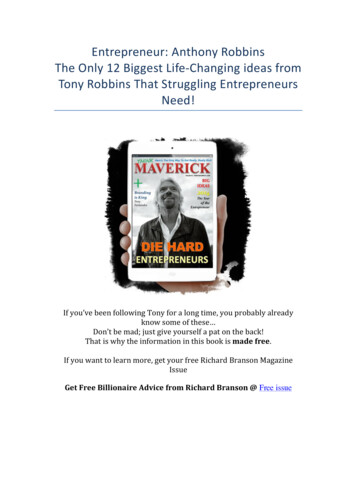
Transcription
View metadata, citation and similar papers at core.ac.ukbrought to you byCOREprovided by ScholarlyCommons@PennUniversity of PennsylvaniaScholarlyCommonsMaster of Applied Positive Psychology (MAPP)Capstone ProjectsMaster of Applied Positive Psychology (MAPP)Capstones8-1-2011Unleashing the Power: Anthony Robbins, PositivePsychology, and the Quest for Human FlourishingStephanie M. RamonesUniversity of Pennsylvania, stephramones@gmail.comFollow this and additional works at: http://repository.upenn.edu/mapp capstonePart of the Other Psychology Commons, and the Social Psychology CommonsRamones, Stephanie M., "Unleashing the Power: Anthony Robbins, Positive Psychology, and the Quest for Human Flourishing"(2011). Master of Applied Positive Psychology (MAPP) Capstone Projects. 21.http://repository.upenn.edu/mapp capstone/21This paper is posted at ScholarlyCommons. http://repository.upenn.edu/mapp capstone/21For more information, please contact repository@pobox.upenn.edu.
Unleashing the Power: Anthony Robbins, Positive Psychology, and theQuest for Human FlourishingAbstractThis paper is written to compare two well-being movements: positive psychology and the self-help movementas modeled by Anthony Robbins, a well-known self-help, motivational and empowerment guru, author andspeaker who has been internationally popular since the 1980s. This paper will analyze both theories of wellbeing and associated interventions that lead to more well-being from both schools of thought, including a casestudy analysis of an intervention conducted by Anthony Robbins at one of his seminars. The author seeks tocreate a bridge between the two fields and propose future research directions using positive psychology as theframework for measurement and analysis of Anthony Robbins’ interventions and techniques.Keywordspositive psychology, self-help, Anthony Robbins, well-beingDisciplinesOther Psychology Psychology Social PsychologyThis thesis or dissertation is available at ScholarlyCommons: http://repository.upenn.edu/mapp capstone/21
Running Head: POSITIVE PSYCHOLOGY AND ANTHONY ROBBINSUnleashing the Power:Anthony Robbins, Positive Psychology, and the Quest for Human FlourishingStephanie Marie RamonesUniversity of PennsylvaniaA Capstone Project SubmittedIn Partial Fulfillment of the Requirements for the Degree ofMaster of Applied Positive PsychologyAdvisor: James O. PawelskiAugust 1, 20111
POSITIVE PSYCHOLOGY AND ANTHONY ROBBINS2Unleashing the Power:Anthony Robbins, Positive Psychology, and the Quest for Human FlourishingStephanie Marie Ramonesstephramones@gmail.comCapstone ProjectMaster of Applied Positive PsychologyUniversity of PennsylvaniaAdvisor: James O. PawelskiAugust 1, 2011AbstractThis paper is written to compare two well-being movements: positive psychology and the selfhelp movement as modeled by Anthony Robbins, a well-known self-help, motivational andempowerment guru, author and speaker who has been internationally popular since the 1980s.This paper will analyze both theories of well-being and associated interventions that lead to morewell-being from both schools of thought, including a case study analysis of an interventionconducted by Anthony Robbins at one of his seminars. The author seeks to create a bridgebetween the two fields and propose future research directions using positive psychology as theframework for measurement and analysis of Anthony Robbins’ interventions and techniques.
POSITIVE PSYCHOLOGY AND ANTHONY ROBBINS3Finding happiness and fulfillment has been as much a part of the human condition asalleviating suffering. As our human existence evolved and developed, so have our approachestowards creating a happy, fulfilling and flourishing life. However, until fairly recently the studyof creating “good” lives has been largely ignored by experimental psychology. This paper iswritten to compare two well-being movements: positive psychology and the self-help movement,as modeled by Anthony Robbins. This paper will analyze the theories of well-being of the twomovements, as well as interventions from each that are intended to enhance well-being. Theauthor seeks to create a bridge between the two fields and open avenues to study the self-helpfield empirically.BackgroundPositive PsychologyThe field of psychology had been shaped by the need for classification and treatment forthe mental illnesses of the soldiers returning from the First World War. Up until that point, thefield of psychology had three distinct purposes: curing mental illness, improving the lives of allpeople, and nurturing what is best in life. The creation of the Veterans Administration andNational Institutes of Mental Heath in 1941 and 1946, respectively, shifted psychology’semphasis onto researching and relieving mental illness (Seligman & Csikszentmihalyi, 2000).Martin Seligman, in his 1998 American Psychological Association presidential address,argued that up until that point psychology had largely focused only on pathologies and sufferingand had ignored the positive side of life. Positive psychology was founded to encourage theunderstanding and fostering of the qualities of life that lead to human well-being, optimalfunctioning, and flourishing (Gable & Haidt, 2005, p. 103; Seligman & Csikszentmihalyi, 2000)and unite the disparate lines of thought on well-being under one field.
POSITIVE PSYCHOLOGY AND ANTHONY ROBBINS4Positive psychology has faced numerous challenges, including psychology’s legacy offocusing on mental pathology and damage, which not only trivializes but also oversimplifies thepositive to be only the opposite of “negative” or simply the absence of the negative (Seligman &Csikszentmihalyi, 2000). In addition, humans seem to have a built-in negativity bias, renderinghuman problems and suffering as more “real”, demanding and memorable in our subjectiveexperience (Baumeister, Bratslavsky, Finkenauer, & Vohs, 2001), making well-being andhappiness seem insignificant to study (Seligman & Csikszentmihalyi, 2000). Lastly, defining thepositive is complex and multidimensional and leads to numerous disputes within andsurrounding the field.Positive psychology was not founded to conflict with “psychology as usual”, or even tomake the rest of psychology “negative;” but instead positive psychology was founded tocomplement psychology (specifically clinical psychology) by expanding its focus (Gable &Peterson, 2005). Positive psychology was founded on the idea that as humans we have theability, agency and desire to live a happy, fulfilling and flourishing life. Positive psychologyargues that not only is flourishing and well-being worth measuring but also that it is measurable.Positive psychology serves as both a lens and methodology for studying the flourishing side oflife, by applying the scientific methods used to the study mental illness and distress to understandmental health and well-being. Seligman (2011) furthers that the study of positive psychology isreally a descriptive process of defining well-being and its levers. So, in positive psychology’sinfancy, the field’s focus has largely been on simply defining well-being, what contributes towell-being (e.g. optimistic explanatory style) and the strengths of individuals (Seligman,Peterson, & Park, 2005). Only recently has positive psychology begun to shift into looking into
POSITIVE PSYCHOLOGY AND ANTHONY ROBBINS5interventions, which puts it as a sharp contrast to the self-help movement.Self-HelpThe self-help movement has been growing exponentially since the late 1950’s with risesnot only in the purchases of self-help books but also in publications of self-help books (Whelan,2004). Self-help books are non-fiction books that make explicit promises for positive change,understanding of personal goals and self-worth and advice for behavior modification (Whelan,2004). Self-help is about using advice and insight to live a better life by empowering theindividual to feel they have control over one’s inner life, expressed behaviors and life outcomes.Self-help books are written for the lay reader and attempt to attract the maximum audience.These titles purport to be of immediate and practical use to the reader, offering instruction andadvice. Unlike academic literature, a self-help book derives its credibility more from anecdotalevidence than from scientific data and research (Whelan, 2004). Self-help books fall intovarious, sometimes overlapping categories including: (a) psychological, dealing with confidence,anxiety and interpersonal relations; (b) spiritual, dealing with religious metaphysics; (c) success,dealing with social achievement and attainment of goals; (d) sexual, regarding physical sexualactivity and its emotional ramifications; (e) disease classifications, dealing with depression,addiction and illness; (f) personal image, especially books on weight loss and body satisfaction;and (g) parenting, including behavioral and medical advice on raising children (Whelan, 2004, p.4).Self-help texts are believed to have been in vogue since the early 17th century, building onthe Puritan ideals of hard work and diligence (Whelan, 2004). Despite most of the self-helpliterature being religious in nature, Benjamin Franklin’s autobiography (1791) seemed to be thesecular pinnacle of self-help books of the time and is still reread as a classic of character
POSITIVE PSYCHOLOGY AND ANTHONY ROBBINS6development, having influenced much of the 20th century self-help books (Starker, 2004).Despite the early success of a secular book, much of self-help and psychology texts entered thepopular stream of thought throughout the early 20th century through the guise of religion (i.e.Alcoholics Anonymous relies heavily on the idea of guidance and strength from a higher powerand Norman Vincent Peale’s (1952) Power of Positive Thinking which offered a sort of spiritualcleansing). As the self-help field developed from the 1930s to the 1950s, the nature of self-helpbecame more secular and pragmatic (however religious and spiritual self-help texts still remainextremely popular) with Dale Carnegie and Dr. Spock rising to popularity. This also marked ashift away from development of character and increased focus on success and happiness as theoutcomes of self-help, also marking the shift in American culture to a more commercial andcapitalistic frame of mind. In the 1960s through the 1980s self-help began to be directed on theinner self, encouraging individuality and self-reflection. It was during this time the New Agemovement, which stresses inner spirituality and understanding of the world, came into vogue.The humanist movement, led by Carl Rogers and Abraham Maslow, was also overtakingpsychology, emphasizing the power and authority of the individual. This led to what self-helpstarted becoming in the 1980s and 1990s and for the most part still is today, a discipline whichfocuses more on personal action and responsibility, which argues that the individual is ultimatelyresponsible in all ways for their distress and well-being (Whelan, 2004). This is the era of OprahWinfrey and Anthony Robbins, where the individual is in control of their well-being and isexpected to not only rise above circumstance but completely overpower it. Individuals seem tobe perpetually seeking personal growth.Some may argue that positive psychology may be the new direction of self-help. Positivepsychology’s interventions are self-help interventions with academic rigor (as demonstrated by
POSITIVE PSYCHOLOGY AND ANTHONY ROBBINS7the placement of popular positive psychology books in self-help sections). These interventionsare meant to be carried out and maintained by the individual. However, they work at asomewhat small scale and focus on cognitive aspects of well-being. Where self-help has beenmainly focused on helping individuals help themselves (or commercial success depending howyou look at it), with little regard to empirically established efficacy; positive psychology hasbeen focused on helping individuals help themselves in a measurable way. In addition, positivepsychology is more focused on observing and describing flourishing in concrete measurableavenues, while the self-help industry justifies its existence is more blindly prescriptive.At the very least self-help helps individuals feel that they are not alone in their struggle andhelps them believe there is escape from their suffering that is within their control. To somedegree individuals that seek out self-help books and techniques already believe they have controlover their lives and behaviors. It is this desire that leads people to not only seek out self-helptexts but to go a further step and attend large conferences and seminars seeking advice anddirection in how to live the optimal life.Who is Anthony Robbins?Anthony Robbins is a well-known self-help, motivational, and empowerment guru,author and speaker who has been popular since the 1980s. In addition to publishing numerousself-help books, selling 35 million books and audio coaching products, Robbins also claims tohave worked with over 4 million people in more than 100 countries. Anthony Robbins conductsmultiple seminars throughout the year including the 4-day long “Unleash the Power Within”(UPW) seminar that is held multiple times a year in different locations around the world. Duringthe UPW seminar participants walk barefoot on hot coals at the end of the first evening’s session.The main point of the seminar is that achieving greatness requires the ability to unleash one's
POSITIVE PSYCHOLOGY AND ANTHONY ROBBINS8personal power and take action. The Date with Destiny seminar is a 6-day live seminar meant toserve as an immersion experience to “understand why you feel and behave the way you do” andteach strategies that “will help you create the happiness, joy, love, passion, success andfulfillment you desire and deserve (retrieved from www.tonyrobbins.com, July 1, 2011).”Anthony Robbins primarily uses strategies from Neurolinguistics programming (NLP; or hisversion of NLP which he calls NeuroAssociative Conditioning), a set of therapeutic techniquesmeant to “reprogram” the individual’s mind by acting on various behavioral-cognitive patterns.Compared to other self-help methods such as books and other self-help seminars,Anthony Robbins takes a much more interactive role with his participants. This is in contrast toother self-help authors and speakers who rarely directly intervene or interact with theirparticipants. Robbins is an interventionist in addition to being a guru. He creates a conversationinstead of just talking at individuals. This paper is meant to look at Anthony Robbins as aninterventionist and will refrain from analyzing the structure and ethics of the Robbinscommercial organization and seminars. In addition, for this paper I will be focusing onRobbins’s fundamental ideas around well-being and human motivation, specifically whatAnthony Robbins argues are the six human needs to set up the framework in which hisinterventions operate in. However, I begin with positive psychology’s theories of well-being andflourishing.TheoryWhat is Flourishing?Flourishing and well-being are notoriously difficult concepts to fully describe and define,as flourishing is neither the absence of illness and suffering nor the pure presence of happinessand joy (Keyes, 2002). To flourish means to live within an optimal range of human functioning,
POSITIVE PSYCHOLOGY AND ANTHONY ROBBINS9one that connotes goodness, generativity, growth, and resilience (Keyes, 2002; Fredrickson,2009).In this section we will briefly overview various theories that aim to describe well-beingconcluding with the most recent theory posited by Martin Seligman.Theories of Well-BeingThere have been numerous theories and approaches to well-being, many of which are notdirectly connected with positive psychology. Many of these argue that well-being can either bereduced to a number of components (i.e. Ryff: Psychological well-being theory) or that one ortwo factors are necessary for well-being above all (i.e. Ryan & Deci: self-determination theory).Maslow (1946) argues that the flourishing individual is a self-actualized individual, where anindividual only becomes self-actualized passing through toll-gates of lower level needs. InMaslow’s hierarchy of needs (1943), one must meet the lowest level of their needs, physiologicalneeds and safety needs in order to survive and without these most basic needs being met onecannot even begin to think of striving towards other forms of well-being (i.e. an individual willneed to feel secure that they will be physically safe in order to expand past thoughts of survival).Ryan and Deci (2001) regard autonomy, competence (similar to environmental mastery)and positive relationships as the basic psychological needs, which must be met if we are toexperience well-being. Ryff (1989) argues that psychological well-being comprises sixcomponents: autonomy, environmental mastery, personal growth, positive relationships, purposein life and self-acceptance (Ryff, 1989; Ryff & Singer, 1998). Diener (2000) emphasizes theimportance of subjective experience and relies on self-reports of subjective well-being (SWB).
POSITIVE PSYCHOLOGY AND ANTHONY ROBBINS10SWB normally refers to what people think and how they feel about their lives1 (Diener, 2000).Huppert (2010) operationalized flourishing to have a set of core features (positive emotions,engagement, interest, meaning and purpose) and a set of additional features (self-esteem,optimism, resilience, vitality, self-determination, and positive relationships) mirroring the formatof the Diagnostic Statistical Manual of Mental Disorders.There seems to be two distinct theoretical approaches to well-being: the hedonicapproach, which is concerned with pleasure, enjoyment and satisfaction; and the eudaimonicapproach, which is concerned with functioning and the realization of our potential (Ryff et al.,2004; Kahneman et al., 1999). Most well-being theories that aim to be comprehensive havecomponents from both approaches.Seligman’s PERMA. Martin Seligman (2002) initially suggested that well-beingresearch could be organized into three categories: the pleasant life, the good life, and themeaningful life. In Flourish (2011), Seligman revised this theory and proposed a broadertheoretical framework for individual well-being and flourishing that built upon and added to hisinitial categories. According to Seligman individual well-being and flourishing encompass fiveindependent components: Positive Emotions, Engagement, Relationships, Meaning andAccomplishment (abbreviated as PERMA). Each of these components was chosen based onthree criteria: (a) it contributes to well-being; (b) it is pursued for its own sake; and (c) it isindependent of the other components.Positive emotion. Experiencing more positive emotions in relation to negative emotionshas been shown to predict subjective well-being (Diener, 2000; Kahneman et al., 1999). If we1Schwarz &Strack (1999) argue that measures of subjective well-being are largely on-the-spotreactions heavily influence by mood and not large, stable, and global evaluations of one’ssatisfaction with life.
POSITIVE PSYCHOLOGY AND ANTHONY ROBBINS11placed all emotions on a spectrum ranging from pleasant to unpleasant, positive emotions (alsoreferred to as positive affect or positivity) include emotions on the pleasant end (e.g., feelinggrateful, upbeat; expressing appreciation, liking), while negative emotions (negative affect ornegativity) represent the unpleasant end (e.g., feeling contemptuous, irritable; expressing disdain,disliking) (Fredickson & Losada, 2005). Most of the literature focuses on positive emotions inthe following ten forms: joy, gratitude, serenity, interest hope, pride, amusement, inspiration,awe, and love (Fredrickson, 2009). The relationship between positive and negative emotionsover time is reflected as a positivity ratio, the ratio of pleasant feelings and sentiments tounpleasant ones over time (Fredrickson & Losada, 2005).Emotions have been explained from an evolutionary perspective because they tend tolead to specific action tendencies. For example, a negative emotion like fear can lead people toescape or attack a potential threat. According to broaden-and-build theory, positive emotionstrigger upward spirals that allow one to broaden awareness and encourage exploration andbuilding of personal coping resources (Fredrickson, 2001). Compared to negative emotions thatnarrow focus towards survival-oriented thoughts and behaviors, as necessitated when one is notmeeting one’s physical needs. Positive emotions have driven humans to evolve and flourish, insocial surroundings when one is safe and secure in meeting one’s physical needs. Positiveemotions are often times fleeting and sometimes mild compared to negative emotions, but mustbe present for well-being to exist and ultimately to flourish (Fredrickson, 2009).A wide spectrum of empirical evidence documents the adaptive value of positiveemotions: including in marriage, friendship, income, work performance, and health (for reviewssee Lyubomirsky, King, & Diener, 2005; Pressman & Cohen, 2005). Evidence suggests that
POSITIVE PSYCHOLOGY AND ANTHONY ROBBINS12positive emotions are not only a product of positive outcomes and well-being but in some wayspositive emotions beget positive outcomes and well-being (Fredrickson, 2001).For example, at the cognitive level, experiments have shown that positive emotions(normally induced through showing the participants a specific video or giving the participant agift) widen an individual’s scope of attention (Fredrickson & Branigan, 2005; Rowe, Hirsch, &Anderson, 2005), broadens behavioral repertoires (Fredrickson & Branigan, 2005), and increasesintuition (Bolte, Goschkey, & Kuhl, 2003) and creativity (Isen, Daubman, & Nowicki, 1987).Positive emotions have also been shown to predict resiliency in the face of adversity and topromote psychological growth (Ong et al., 2006; Fredrickson, Tugade, Waugh, & Larkin, 2003).In the physical body, experiments have shown that induced positive emotions speed recoveryfrom the effects of anxiety on cardiovascular system (Fredrickson, Mancuso, Branigan, &Tugade, 2000), and increases immune function (Davidson et al., 2003). In addition, there is alsolink between frequent positive emotions and longevity (Pressman & Cohen, 2005; Moskowitz,2003; Levy, Slade, Kunkel, & Kasl, 2002; Danner, Snowdon, & Friesen, 2001; Ostir, Markides,Black, & Goodwin, 2000).Positive emotions are, by nature, a subjective component of PERMA and can only beobserved by asking the individual (Seligman, 2011). Even though it can be argued that wellbeing is reducible to positive emotions and happiness, it does not completely capture all of wellbeing (Seligman, 2002). Specifically it does not allow for those who have inherited lowerpositivity ratios or are not outwardly expressive to be considered to be flourishing (Seligman,2011). In addition, people focused solely on attaining positive emotions find themselves on ahedonic treadmill, where people adapt rapidly to positive changes in their world and soon returnto their baseline levels of happiness (Brickman & Campbell, 1971; Kahneman, 1999; Lykken &
POSITIVE PSYCHOLOGY AND ANTHONY ROBBINS13Tellegen, 1996). Positive emotions are an important aspect of flourishing but positive emotionsare not all of flourishing.Engagement. The engaged life is a life that pursues engagement, involvement andabsorption in work, intimate relations, and leisure (Seligman, 2011; Csikszentmihalyi, 1990).Csikszentmihalyi (1990) argues that ultimately the self interprets the information and that ourintentions can guide and focus our attention. When all the information taken in aligns with anindividual’s goals, passions, purpose and enjoyment, and when the activity’s challenge levelmatches an individual’s skill level, the individual experiences “flow.” When a person is in a stateof flow they are in a feeling of energized focus, full involvement, and success in the process ofthe activity. In flow, time passes quickly, attention is completely focused on the activity and thesense of self is lost (Csikszentmihalyi, 1990).Living in a state of flow is sometimes thought of as the extreme end of engagement, andis difficult and exhausting to maintain. Getting into a state of engagement or flow is difficult tofully describe and operationalize. Csikszentmihalyi (1990) argues that the good life is one wherewe experience flow and are engaged with life as much as we can. The engaged life is onegrounded in the present. Maximizing states of flow and engagement is associated with reducedlevels of depression and anxiety (Nakamura & Csikszentmihalyi, 2002). Engagement is also anaspect of PERMA that can only be assessed subjectively but is different from positive emotion inthat by its inherent nature you only notice flow and engagement retrospectively.Relationships. Having positive relationships has been cited as the most important lifegoal and social support has been shown valuable for recovery from illness, physiologicalfunctioning and mental health (Cohen & Herbert, 1996; Reis & Gable, 2003).
POSITIVE PSYCHOLOGY AND ANTHONY ROBBINS14At the most basic level relationships move toward well-being in providing a supportnetwork that contributes to an individual’s feeling of security, which allows them to broaden outand flourish (Fredrickson, 2002). Social support is the feeling of connectedness and comfortgiven to us by our peers, family, friends and significant others (Carver, Schier, & Weingtraub,1989). It is the feeling that at 3 a.m. when you are in trouble, you have someone that you cancall for help (Isaacowitz, Valliant, & Seligman, 2003). It is feeling and knowing that someone isthere for us in both bad and good times. Seeking social support for instrumental reasons isseeking advice and information. Seeking social support for emotional reasons is seekingunderstanding or sympathy and tends to be used more for outlets for ventilation of one’s feelings(Carver, Scheier, & Weintraub, 1989). Feeling that one has social support greatly influencestheir feelings of well-being and can buffer against depressive symptoms (Bebbington, 1996;Brugha, 1990).On the negative side, relationships can be one of the most powerful causes of distress(Cacioppo & Patrick, 2008). For example, death of a spouse and close family members are someof the most traumatic life events (Holmes & Rahe, 1967). In addition, troubled relationships andloneliness tend to be most common presenting problem in psychotherapy and have been linked toincreased proclivity to depression and suicide attempts (Zayas et al., 2009; Cacioppo et al., 2006;Belle & Doucet, 2003; Pinsker, Nepps, Redfield, & Winston, 1985).Although it is clear that relationships contribute towards well-being and are independentof the other components, it is unclear whether relationships are sought for their own sake or forpositive emotions (Seligman, 2011). However, as demonstrated by the debilitating and uniquesuffering created in a relationships’ absence, there is a force around relationships that drive
POSITIVE PSYCHOLOGY AND ANTHONY ROBBINS15humans to seek others out and rely on them. People need other people; individuals generally willnot flourish in isolation.Meaning. When an individual understands their unique fit in the world and identify whatthey are trying to accomplish in their lives, they are said to have the presence of meaning in theirlife (Steger et al. 2009). Meaning refers to belonging and serving something that you believe isbigger than the self and is inherently outward driven.Several investigations have established a positive link between meaning in life and wellbeing (Steger et al., 2009; Steger et al., 2008; King, Hicks, Krull, & Del-Gaiso, 2006; Mascaro &Rosen, 2005; Reker, 2005; Steger & Frazier, 2005; Steger, Frazier, Oishi, & Kaler, 2006; Urry etal., 2004; Ryff & Singer, 1998; Ryff, 1989; Reker, Peacock, & Wong, 1987). Those who have asense of meaning to their lives have been found to be more optimistic (Compton et al., 1996) andhave higher self-esteem (Steger et al., 2006). Those with a sense of meaning also report lessdepression and anxiety (Steger et al., 2006) and less suicidal ideation (Harlow et al., 1986).However, search for meaning, activity of people’s desire and efforts to establish and/or augmenttheir understanding of the meaning, significance, and purpose of their lives, tends to beassociated with a lack of meaning and those individuals that identify as searching for meaningare less satisfied with their lives (Steger, Frazier, Oishi, & Kaler, 2006; Steger, Kashdan,Sullivan, & Lorentz, 2008).Part of meaning is subjective in that you determine what feels meaningful for your ownlife but logic and reason can also weigh the meaning of your life. People find meaning in theirlives through various means including positive relationships, accomplishment, and altruism.Meaning becomes a target for the individual to strive towards, and without it the individual doesnot thrive. Having a sense of meaning in one’s life is what will keep the person living versus
POSITIVE PSYCHOLOGY AND ANTHONY ROBBINS16purely trying to survive and also seems to be what helps pull people through adverse situations.Without meaning the person will be grounded in the past and present and will not be able to pushinto the future (Seligman, 2011).Accomplishment. Accomplishment and achievement represents an individual’s ability toexert mastery over their environment (Seligman, 2011). Accomplishment allows the individual ameasurable way to know their actions are meaningful and to allow them to feel efficacious intheir actions. This provides the individual a sense of control in the path of their lives and givesfeedback to the individual that they are on the right path. Unlike meaning, accomplishment ismore focused on the feedback
Unleashing the Power: Anthony Robbins, Positive Psychology, and the Quest for Human Flourishing Abstract This paper is written to compare two well-being movements: positive psychology and the self-help movement as modeled by Anthony Robbins, a well-known self-help, motivational and empowerment guru, author and










